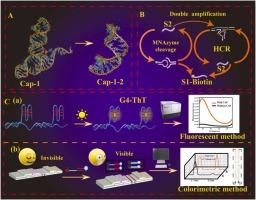G-quadruplex fluorescent and lateral flow colorimetric aptasensor for the detection of capsaicin in illicit cooking oil
IF 8
1区 化学
Q1 CHEMISTRY, ANALYTICAL
引用次数: 0
Abstract
The safety of cooking oil is a major global concern and capsaicin (CAP) serves as a crucial marker for assessing its quality. To address this issue, we have devised an innovative biosensor using a truncated aptamer, Cap-1–2, as the foundation for a dual-mode aptasensor. The aptasensor employs a combination of Mg2+-dependent DNAzyme (MNAzyme) cleavage and hybridization chain reaction (HCR) to achieve highly sensitive CAP detection. Notably, the fluorescence signal originates from the inherent fluorescence of thioflavin T (ThT) embedded in a G-quadruplex (G4) structure, enabling the detection of CAP in high-throughput oil samples. Additionally, the biosensor employed the MNAzyme to cleave biotinylated DNA (S1-Biotin), which is subsequently ligated to functionalized gold nanoparticles (AuNPs-Poly A-cDNA), generating outstanding colorimetric signals on lateral flow test strips for immediate point-of-care testing (POCT). The linear detection ranges of the established fluorescence and colorimetric aptasensor were 0.15–80 ng mL−1 and 0.2–100 ng mL−1, respectively, and the limits of detection (LOD) were 0.054 ng mL−1 and 0.137 ng mL−1, respectively. These results demonstrate the practicality of the aptasensor for detecting CAP in real-world samples. Moreover, the aptasensor surpasses traditional biosensors in terms of high-throughput, portability, and sensitivity, making it highly promising for rapid detection in the food industry.

用于检测非法食用油中辣椒素的 G-四重荧光和横向流动比色适配传感器
食用油的安全性是全球关注的一个主要问题,而辣椒素(CAP)是评估食用油质量的一个重要标志。为了解决这个问题,我们设计了一种创新的生物传感器,使用截短的适配体 Cap-1-2 作为双模式适配体传感器的基础。该传感器采用 Mg2+ 依赖性 DNA 酶(MNAzyme)裂解和杂交链反应(HCR)相结合的方法来实现高灵敏度的 CAP 检测。值得注意的是,荧光信号来源于嵌入 G 型四联体(G4)结构中的硫黄素 T(ThT)的固有荧光,从而实现了对高通量油样中 CAP 的检测。此外,该生物传感器还利用 MNA 酶裂解生物素化 DNA(S1-生物素),随后将其连接到功能化金纳米粒子(AuNPs-Poly A-cDNA)上,在横向流动检测条上产生出色的比色信号,从而实现即时护理点检测(POCT)。所建立的荧光和比色传感器的线性检测范围分别为 0.15-80 纳克毫升-1 和 0.2-100 纳克毫升-1,检测限(LOD)分别为 0.054 纳克毫升-1 和 0.137 纳克毫升-1。这些结果证明了该灵敏传感器在实际样品中检测 CAP 的实用性。此外,该适配传感器在高通量、便携性和灵敏度方面都超越了传统的生物传感器,因此在食品行业的快速检测中大有可为。
本文章由计算机程序翻译,如有差异,请以英文原文为准。
求助全文
约1分钟内获得全文
求助全文
来源期刊

Sensors and Actuators B: Chemical
工程技术-电化学
CiteScore
14.60
自引率
11.90%
发文量
1776
审稿时长
3.2 months
期刊介绍:
Sensors & Actuators, B: Chemical is an international journal focused on the research and development of chemical transducers. It covers chemical sensors and biosensors, chemical actuators, and analytical microsystems. The journal is interdisciplinary, aiming to publish original works showcasing substantial advancements beyond the current state of the art in these fields, with practical applicability to solving meaningful analytical problems. Review articles are accepted by invitation from an Editor of the journal.
 求助内容:
求助内容: 应助结果提醒方式:
应助结果提醒方式:


